Black Is Beautiful
Cold
Marble
Waits
Trampled
Odd feet
Proud and bold
Take your stand
On the cold
Floor of success
You made it through that
Segregated door
The bar is open
Not two but one
first
This day has just begun
Black is beautiful
Rock
Held high
No straightening comb
No creams to buy
Bleach not
Thy tone to honey skin
Ebony’s day
Shall now begin
Yes
Black is beautiful
A term
Long held
Men like Rock
Broke
The proverbial spell
No paper bag
Shall set the tone
Ebony
No longer
Stands
Alone
Written by: Melvina Germain
Inspired by: John Rock & Black Is Beautiful
Afros, locks and naturals – all symbols of a powerful movement that began with the word of John S. Rock, an African-American abolitionist who was the first black person to be admitted to the bar of the Supreme Court of the United States. Rock would paraphrase the term “Black is Beautiful” during a speech back in 1858.
Some 100 years later, African Americans would begin a movement illustrating Rock’s words, which encouraged men and women to stop straightening their hair and attempting to lighten or bleach their skin with creams.
The Black is Beautiful movement became the most prominent in the writings of author Steve Biko in his book, the “Black Consciousness Movement” in South Africa. The book and the movement aimed to dispel the notion in many world cultures that black people’s natural features such as skin color, facial features and hair are inherently ugly. It was meant to dispel the stigma of internalized racism, which caused such things as “paper bag parties” in the black community, where only those with a skin color lighter than a brown paper bag were permitted.
The idea of Black is Beautiful led to the Black nationalist and Uhuru movement of the 60’s and 70’s where the world would be introduced to legends like Malcolm X, Frantz Fanon, Marcus Garvey and Elijah Muhammad. By 1969, there were black characters on 21 primetime television shows.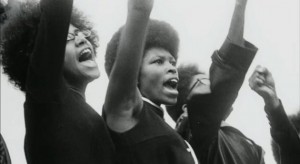 Black History Month, happens every year in the month of February. I believe Black History should be everyday. There is so much to learn, we need more that one month per year to focus on Black History. Everyday, find something new to focus on, learn it and file in your brain and teach others, black and white. We have much to be proud of, we know those that went before us suffered much and they should not be forgotten. We need to know who we are and to love our ancestry, we have many stories to tell.
Black History Month, happens every year in the month of February. I believe Black History should be everyday. There is so much to learn, we need more that one month per year to focus on Black History. Everyday, find something new to focus on, learn it and file in your brain and teach others, black and white. We have much to be proud of, we know those that went before us suffered much and they should not be forgotten. We need to know who we are and to love our ancestry, we have many stories to tell.
One of the main illustrations of the Black is Beautiful movement was the Don Cornelius’ 1969 creation of Soul Train. With a full African American cast of dancers and advertisers targeting the Black is Beautiful movement, Soul Train was the first and largest outreach to the black community that glamorized the physical diversities of Black America. The legacy lasted for three decades on television.
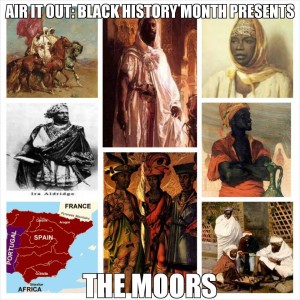
THE MOORS
The Moors….One of my favorite subjects. The Moors are African people, who are most famous for venturing into Spain and many parts of Europe, deposing of tyranical barbarians, helping to reestablish civilization among the europeans, the importing of their great knowledge, resources and advances, their influence on art, music, and acedemic/philosophical thought, their establishment of the first universities, and leaving an indelible mark on the WORLD as a whole.
Now history or rather those who have hijacked history to tell, HIStory..have tried to cover the fact that the Moors were Black African people. These biased scholars and historical charlatans will use tactics such as, saying that the Moors were non-black Arabic people.
Now it is true that some Moors were Arabic, but first and foremost Arabs just like all other humans descend from Black African people and Arabic is orginally an African language. Furthermore, while there were a significant amount of Arabic Moors, most of the Moors were black Africans from the northern portions of Africa.
” Tarik, a great African chief, was given the rank of general in the Arab army and sent to raid Spain. On April 30, 711, Tarik landed on the Spanish Coast with 7,000 troops. His troops consisted of 300 Arabs and 6,700 native Africans (Moors). An ancient source, Ibn Husayn (ca. 950), recorded that these troops were “Sudanese”, an Arabic word for Black people.”
Another misconception is that all the Moors were of Islamic faith. Now truthfully many were, but its a little deeper than that.
The Prophet Muhammad established the religion of Islam; which was an amalgamation of various concepts and ideologies which was orginally established by Black Africans well over 10,000yrs before the rise of the hebrew and christian belief systems and indeed those systems were both loosely based on African Spirituality; and with his new religious concept Muhammed spread his message among the Arab world.
” Consumed with religious fervor, the Arabs sought to spread Islam and conquer the world. By 708, the Arabs had overrun North Africa.”
However, even though the Arabs conquered the North Africans militarily, the North Africans conquered the Arabs mentally and spiritually. Since Africa was in fact the birthplace for intellectual and spiritual thought and highly developed concepts, the North Africans reinfused Islam with the concepts of original African science and spirituality.
The Moors went into Spain, and were welcomed by many of the europeans residing in Spain, who were being oppressed by a tribe of barbarians known as the Visigoths who were very cruel and inhumane. The Moors defeated the Visigoths, and pushed them northward. However, soon after, the Moors had a falling out with the Arabs.
” The Moors of Africa were the real conquerors. When the Arabs arrived, the hardest part of the job had been done. Instead of treating the Moors fairly, the Arab chiefs assigned themselves the most fertile regions. The dissatisfied Moors were not long in coming to blows with the Arabs. (The History of Spain by Louis Bertrand and Sir Charles Petrie – published by Eyre & Spottiswood, London, 1945, page 36). Ultimately, the Moors acquired two-thirds of the peninsula, which they named Al-Andulus.
Al-Andulus was obliged to pay tribute to the Arab Caliph (King) of Damascus. As Al-Andulus acquired its own identity, its bond with the Caliph began to weaken. In 756, Al-Andulus proclaimed itself an independent state. Thus, its only links to the Arabs would be the Islamic faith and the Arabic language.”
Al-Andulus florished for a long period of time. A strong contributing factor to this, is the fact that the people residing there were allowed to live in relative peace and freedom.
Even though many of the Moors practiced Islam, the white europeans were allowed to still remain christian, jewish, or any other belief system or lifestyle they so choose, there were even Moors who practiced forms of Christianity or other philosophies/belief systems.
The Moors re-introduced european to the lost greek philosophies which were based on the African Philosophies that the Greeks often admitted they learned from Africans. The Moors introduced advanced architecture, and other feats of ingenuity, such as food preservation, complex irrigation and sanitation systems, and even running hot/cold water.
The Moors also built great universities, that predate places such as Cambridge. It was The Moors that first introduced to the European world the concept of a round Earth, since the Moors, and Black Africans in general had already navigated the entire planet numerous times for thousands of years.
The Moors brought so much prosperity to Al-Andulus, and many other parts of Europe, that not only did other european rulers become jealous and envious of their success; but they begin to plot an scheme on how to get their hands on it, motivated and fully seduced by selfishness and greed. This is how the Crusades started.
The crusades were one of the first big exercises in mass propaganda. The crusades were not about christians trying to free the so called holy land from muslim occupation and oppression, the crusades were greedy european rulers who wanted to get their hands on the land and riches The Moors had acquired.
Through religious brainwashing and manipulation of information, they tricked the masses of their people into doing the dirty work. Ironically, some of the first people that white european crusaders ended up slaughtering, were their own fellow white europeans who were residing peacefully in Al-Andulus.
Eventually, like most things in life the reign of the Moors eventually came to an end. Most notably with the expulsion of a large portion of the Moors, by the armies of King Ferdinand and Queen Isabella in the year 1492(this is the real reason why HIStory has kept that year important, not because of Columbus and his invasion voyage, I mean voyage of discovery…lol).
However, even after the fall of their empire, The Moors still continued to have a profound and dynamic effect on Europe and the world at large. Many notable europeans are of Moorish descent, including Mozart and Pushkin just to name a few. Moorish science, art and philosophy continues to influence the world. And no matter how some have tried to cover, hide, or white wash their story, the evidence of their presence remains.
The Moors left a mark on World History, that not only brings clarity and understanding to anyone with an open mind craving knowledge, but also it is a mark of pride, that gives any man woman or CHILD of African descent, a reason to hold THEIR HEADS HIGH!!!!!
(Below you will find links to websites and youtube videos with much more information on THE MOORS)
HOTEP/ASE’/AMEN
http://electronicvillage.blogspot.com/2011/04/ourstory-moors-of-north-africa.html?m=1
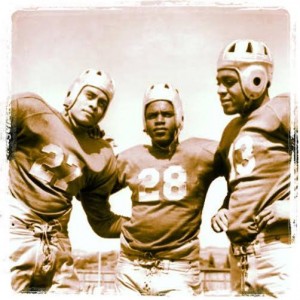
Gridiron pioneers, Kenny Washington and Woody Strode, who, in 1946, became the first African American men to play in the modern day NFL when they signed with the LA Rams. CA natives, they first played along side Jackie Robinson (pictured here) and Ray Bartlett for the UCLA Bruins football team–making up part of a group of historic four black backfield players. (Historic because at that time, only about a dozen black players played in major college football programs throughout the country.) #BHM2014
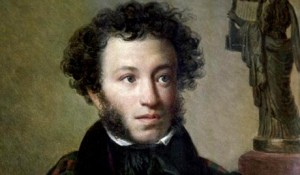
Alexander Pushkin (1799-1837)
Alexander Sergeyevich Pushkin was a Russian author of the Romantic era who is considered by many to be the greatest Russian poet and the founder of modern Russian literature. Pushkin published his first poem at the age of 15, and was widely recognized by the literary establishment by the time of his graduation from the Tsarskoye Selo Lyceum.
Pushkin was born into Russian nobility in Moscow. His great-grandfather from his mother’s side, Abram Petrovitch Ganibal, was enslaved and brought over from Africa to Russia where he rose to become an aristocrat. Ganibal was the favored general of Peter the Great, highly proficient in mathematics, engineering, and cryptology and treated as a member of the royal family. Pushkin’s historical fiction “The Blackamoor of Peter the Great” is based on his great-grandfather.
Even though he was considered nobility, Pushkin often faced racism because of his African heritage. His jaded yet proud defense of his ancestry in “My Genealogy” is in response to racial slurs aimed at him by his critics.
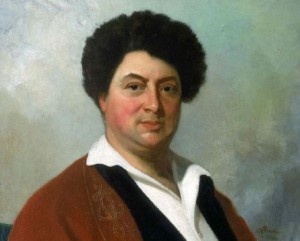
Alexandre Dumas (1802-1870)
Alexandre Dumas was a prolific French playwright, historian, and author, and is best known today for his historical novels of high adventure. Translated into nearly 100 languages, these have made him one of the most widely read French authors in history. Many of his novels, including “The Count of Monte Cristo”, “The Three Musketeers”, “Twenty Years After”, and “The Vicomte de Bragelonne: 10 Years Later” were originally published as serials. His novels have been adapted since the early-20th century for nearly 200 films.
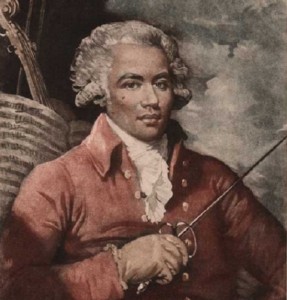
Le Chevalier de Saint-George (1745-1799)
Joseph Boulogne, Chevalier de Saint-George, was an important French-Caribbean figure in the Paris musical scene in the second half of the 18th century. In his lifetime Saint George became an elite musketeer of the King’s Horse Guard; a master-swordsman and Europe’s fencing champion; a composer, violin impresario, and opera director that influenced Mozart, and a military hero in the French Revolution—ironically all in an age when slavery was endemic and white superiority was dogma.
Known as the “Black Mozart,” Boulogne was one of the earliest musicians of the European classical type known to have African ancestry. He was born on Dec. 25, 1745 on the Caribbean island of Guadeloupe, to Nanon, a Senegalese woman who was formerly enslaved and Georges Boulogne de Saint-George, a white French plantation owner. Joseph acquired the name de Saint-George, after one of his father’s properties.
Dumas was born on July 24, 1802 in the village of Villers-Cotterêts, just outside of Paris, the third child born to Marie Louise Labouret, daughter of an innkeeper, and Thomas Alexandre Davy de la Pailleterie a military General under Napoléon. Alexandre’s grandfather, the Marquis Alexandre Davy de La Pailleterie married an enslaved Black woman from San Domingo (now Haiti) named Marie Louise Césette Dumas. Thomas took her last name when he enlisted with the French army.
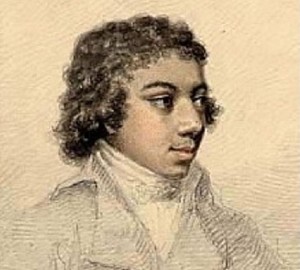
George Polgreen Bridgetower (1780-1860)
George Augustus Polgreen Bridgetower was an Afro-Polish-born virtuoso violinist who lived in England for much of his life. He was the son of Frederich Bridgetower, an African prince and a Polish woman of German descent named Mary Ann.
Bridgetower demonstrated an exceptional musical talent that pushed his parents to send him to London. After a year at the Drury Lane Theater in London under the patronage of the Prince of Wales, he studied music with renowned masters such as Franz Josef Hadyn, Francois Hyppolite Bartelemon Jarnovich and Giovanni Mane Giornovichi.
For 14 years, he played in the orchestra of the Prince Royal Pavilion in London. In May 1803, he is 23 years old when he meets in Vienna, Ludwig von Beethoven. They work together and Beethoven was so impressed with Bridgetower’s mastery of the violin, he dedicated the “Violin Sonata” to him and titled it “Sonata Per Uno Mulaticco Lunattico.”
The piece is now known in history under the title “Kreutzer Sonata”, because a reportedly racist remark by Ludwig von Beethoven to his friend Bridgetower broke up their friendship. Beethoven then decided to re-dedicate the sonata to Rudolf Kreutzer and changed the title to “Kretzer Sonata.”
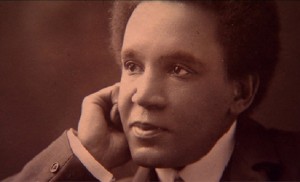
Samuel Coleridge-Taylor (1875–1912)
Samuel Coleridge-Taylor was born Aug. 15, 1875 in Holborn, England (a suburb of London). His father, Daniel Hughes Taylor, was a native of Sierra Leone who left Africa to study medicine in England. His mother, Alice Hare Martin, was an Englishwoman. Daniel Taylor
By 1896, Coleridge-Taylor had earned a reputation as a composer. His greatest success was undoubtedly his cantata “Hiawatha’s Wedding-feast,” which was widely performed by choral groups in England during Coleridge-Taylor’s lifetime and in the decades after his death. Its popularity was rivaled only by the choral standards Handel’s “Messiah” and Mendelssohn’s “Elijah.” Coleridge-Taylor also composed chamber music, anthems, and the African Dances for violin, among other works. “The Petite Suite de Concert” is still regularly played.
The famed composer was received in America much more warmly than in England, where he suffered intense racism. He visited the USA three times, receiving great acclaim, and earned the title “the African Mahler” from the white orchestral musicians in New York in 1910. African Americans greatly admired Coleridge-Taylor, and in 1901, a 200-voice African-American chorus was founded in Washington, D.C., named the Samuel Coleridge-Taylor Society. He was, and remained till his death, an ardent supporter of the Pan African Movement.
Black Holocaust
Lived, life’s wretched pigs of society
annihilated a people innocent and pure
Raped their future
Stole their land
Blood filled puddles soaked earths crust
Weary souls turned to dust
Scattered memories of a working few
Hatred spewing the likes of you
Hidden secrets
History untold
Not a tear hangs an oppressors eye
Not a compassionate word least a lullabye
Evil soared virgin land of the dead
A black sheet draped where bodies bled
A blood red veil, dark sorrow, shadows reign
Ne’re a mystery finds God’s weeping pain
Written by: Melvina Germain
Date: Feb. 15/2013
References: Nubian Queens in the Nile Valley and Afro-Asiatic Cultural History – Carolyn Fluehr-Lobban, Professor of Anthropology, Museum of Fine Arts, Boston U.S.A, August 20-26, 19
You’ve heard the term “Black Jews”…take a look at this snap shot of history.
The Kandakes of Kush.
Kandake, also known as Candace, Kendake or Kentake was the title for queens and queen mothers of the ancient African Kingdom of Kush, also known as Nubia and Ethiopia. They were known as Nubian warrior queens, queen regents, and Ruling queen mothers. They controlled what is now Ethiopia, Sudan, and parts of Egypt. They co-ruled the Meroitic with their brothers (not their husbands), a trait of matrilineal societies. They were buried with rich treasure in their own pyramids. Reliefs dated to about 170 B.C. reveal Kandake Shanakdakheto, dressed in armor and wielding a spear in battle. She did not rule as queen regent or queen mother but as a fully independent ruler. Her husband was her consort. Reliefs found in the ruins of building projects she commissioned, Shanakdakheto is portrayed both alone as well as with her husband and son, who would inherit the throne by her passing. One of the most well known Kandakes was Amanishakheto known for defeating the Roman invasion of Nubia by Augustus and subsequently brokering a favorable peace treaty. Conclusion The “Kandakes/Candaces” serve as examples of women as powerful figures or clever strategists in their roles as queens, as warrior queens, or as romantic figures, they have had great appeal in times past, and will continue to do so in this present era of humanist interest in the subject.
A Gift from a poet friend…Neon
Egyptian Queen
I met a queen many years ago
that looked the image of you
she had a talent for words
and shared it with the world
She was mine
and we made temples together
she had stars in her eyes
and she had stars in her mind
I called her sister in the old days
and somewhat have seen her again
she is a friend and poet
and I am glad to call her friend
So dear lady
I call you my Egyptian Queen
By Christos Andreas Kourtis aka NeonSolaris
Written for: Melvina Germain

Jumping The Broom
A brief description of “Jumping The Broom”
First of all, let me state that “Jumping The Broom” is an
African American phrase and was not a custom of slavery.
It is a part of African culture and did survive American
slavery. Some couples now will refer to this phrase in
tribute to the custom while others will actually jump the
broom. The phrase “Jumping The Broom” is synonymous
with getting married the same way the phrase “Tying The
knot” is.
The tradition originated in West Africa, county of Ghana.
The brooms were used to keep the Asante’s urban areas and
roads clean and subsequently the wives or servants used the
same brooms to clean the courtyards, palaces and homes.
The broom held a spiritual value in the Asante and Akan
cultures and symbolized sweeping away past wrongs and
removing evil spirits. The brooms were waved over the
heads of the marriage couple in order to ward off evil spirits.
At the end of the ceremony, often not always the couple
would jump over the broom. Doing so, was a commitment
on the part of the wife as by doing this, she agreed to keep the
courtyard clean of the new home she had joined and also an
overall commitment to the house.
Whoever jumped the highest was the decision maker and
in most cases was the husband. Realize “The Jumping Of
the Broom” does not add up to a “Leap Of Faith”…..
Compilation by: Melvina Germain
Langston Hughes wrote: Under my hand the pyramids arose
I made the mortar for the Woolworth Building.
Let’s learn about (The Dozens)
To be involved in a ritual called the dozens, you had to be cool and full of quick wit.
This term was applied to a rather crude ritual among African Americans, Who verbally
bantered back and forth, insulting each other. The winner was the person whose wit led
him far. Having said that, the game came from slavery. It is said when slave owners
had exceptional merchandise, they were sold separately. If some slaves were ill or
feeble in some way, they were sold in packs of a dozen, thus the terminology “The
dozens”. One can see, though Black people became free, still the mindset of slavery was
instilled in them as they carried forth such a game. More detailed information can be
found in “The Black Book” 35th Anniversary Edition by Middleton A. Harris, with the
assistance of Morris Levitt, Roger Furman, and Ernest Smith.
Harriet Tubman said: I freed a thousand slaves and would have freed a thousand more,
if only they knew they were slaves…
I do believe today, we are still living a life of slavery, the difference is, all colors
are involved. Sill we are ruled by the mighty few, though we are the majority.
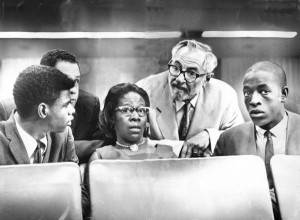
RENA PRICE
On June 29/2013 a black sister age 97 passed away and few knew who she was. Rena Price was a strong Black woman who intervened when an officer pulled one of her sons over. It is said her interaction with the police was what set off the 1965 Watts riot.
Rena rushed to a traffic stop in los Angeles, California where a Highway Patrol Officer and her son were in altercation. Upon arriving an incident took place, Rena jumped on one of the officers, tearing his shirt after witnessing an officer hit her son over the head with a baton.
One of the officers pulled out a shotgun but no shots were fired.
Rumours spread that police had roughed up a Black woman, angry mobs formed and a riot which lasted six days occurred. 34 people were killed, over a thousand injured and hundreds of buildings were damaged or destroyed.
Her family changed their last name after this incident, her son Marquette Frye was arrested many times thereafter and died of pneumonia in 1986 at age 41. Apparently Rena was without work for a very long time, blaming it on the incident, indicating no one would hire her.
Rena was found guilty and was given a 30 day jail sentence which was reduced to two years probation. That was later appealed and her conviction was reversed, due to prejudicial remarks the prosecution had made to the jury, blaming Rena for the riots of 1965. Later the riots of
1992 took over and placed a blanket over the 1965 riots.
Rena indicated she made it through that harsh storm and moved forward when she was finally employable again.
Often I sit and ponder, what would it have felt like to walk on the ground of my ancestors and feel it warmth. Well, it hasn’t happened thus far, though we never know what the future will bring. At this time I have no address in Africa but my heart still belongs there. I wrote the following poem to share some of my feelings with all of you.
I Miss You Mother Africa
I miss you Mother Africa,
your native words are on the tip of my tongue
screaming to come forth.
The sound of beating drums lay etched
within my soul, longing to be heard again.
The soft bed of earth bare on my feet,
I will never feel,
the wisdom of my tribes chief
I will never hear.
I miss you Mother Africa,
though my body was never there.
I feel you in my heart
and see you in my child’s fingertips.
As you come forth throughout the years
your art will always shine.
Truth of ones identity is never left behind.
Though ripped from the womb of love
and scattered among a nation.
I find you,
on canvass’s and art shirts
of a daughter’s art creation.
I miss you Mother Africa,
though you never left my soul.
Your vibrant color ,
your lines of amazement,
shine blatantly and has helped
to make me whole.
I miss you Mother Africa,
may your beauty always shine within me.
One day your truth will soar throughout the world,
your land will reap it’s glory,
and all who doubted you,
will bask in your great story.
I miss you Mother Africa.
Written by: Melvina Germain
New Quote
We fear the devil because the devil is without shame, we praise only one God for we are taught, several Gods is the imagination of the wicked. Bow to no human, humans are flesh and bone and all created equal. Class and status bear the greedy and numbered paper lines the pockets of false prophets. An M.G. Quote
Africa O Poor Africa
Why does the mother country “Africa” still remain in chains and very little is done about it. When great leaders are continually removed without justice prevailing. When no one seems to give a darn, we see that the demons of slavery still exist and we are still in much need of a revolution. When those who try to climb that
ladder to create a fair and better life for the people of a great country, and continually tossed back on the ground in blood pools. One after another, we realize our mother country is still held tightly in chains. We can not build a bridge of love when hate is so strong and prevalent. Many good and honest leaders have lost their lives by the hands of the oppressor and still justice has not been served. Leaders such as this well loved leader “Thomas Sankara”.
Indeed, Africa and the world are yet to recover from Sankara’s assassination. Just as we have yet to recover from the loss of Patrice Lumumba, Kwame Nkrumah, Eduardo Mondlane, Amilcar Cabral, Steve Biko, Samora Machel, and most recently John Garang, to name only a few. While malevolent forces have not used the same methods to eliminate each of these great pan-Africanists, they have been guided by the same motive: to keep Africa in chains.
Quote: I do not seek revenge, however I do require justice. An M.G. Quote
Did you know
A black man helped Jesus carry the cross
Amazing Grace is played on all the black keys
A Black Woman ran for President many years ago
A Black man had the book “Little Black Sambo” removed from the schools in Canada
The Black race are the only people not compensated for their travesty of slavery. All other races have been compensated for their travesties.
Did you know the reason why the hominoid named Lucy does not have an African name. The anthropologists were playing the Beatles song while searching through the bones and decided to call her Lucy rather than give her an African name.
© 2013 Above The Rain (All rights reserved)
ipt async src=”//pagead2.googlesyndication.com/pagead/js/adsbygoogle.js”>
Thankyou to Michelle Goshinmon for sharing this snap shot of Black History
The Legend of Stagecoach Mary
Also known as Mary Fields, Stagecoach Mary was one of the toughest ladies of the Old West. Born as a slave on a Tennessee plantation in 1832, she gained her freedom after the Civil War and the resulting abolition of slavery. After the Civil War Mary made her way West where she eventually settled in Cascade County, Montana.
In Montana, Mary would gain a reputation as one of the toughest characters in the territory. Unlike most women of the Victorian era, Mary had a penchant for whiskey, cheap cigars, and brawling. It was not uncommon for men to harass her because of her race or her gender. Those who earned her disfavor did so at their own risk, as the six foot tall, two hundred pound woman served up a mean knuckle sandwich. According to her obituary in Great Falls Examiner, “she broke more noses than any other woman in Central Montana”.
In Montana, Mary made a living doing heavy labor for a Roman Catholic convent. She did work such as carpentry, chopping wood and stone work. However, it was her job of transporting supplies to the convent by wagon that would earn her the name “Stagecoach Mary”. The job was certainly dangerous as she braved fierce weather, bandits, robbers and wild animals. In one instance her wagon was attacked by wolves, causing the horses to panic and overturn the wagon. Throughout the night Stagecoach Mary fought off several wolf attacks with a rifle, a ten gauge shotgun, and a pair of revolvers.
Mary’s job with the convent ended when another hired hand complained it was not fair that she made more money than him to the townspeople and the local bishop. When the bishop dismissed his claims, he went to a local saloon, saying that it was not fair that he should have to work with a black woman (he said something much more obscene). In response, Mary shot him in the bum. The bishop fired Mary, and she was out of a job.
After a failed attempt at running a restaurant, Stagecoach Mary was hired to run freight for the US Postal Service. Today she holds the distinction of being the first African American postal employee. Despite delivering parcels to some of the most remote and rugged areas of Montana, Mary gained a reputation for always delivering on time regardless of the weather or terrain.
At the age of seventy, Stagecoach Mary retired from the parcel business and opened a laundry. In one incident when a customer refused to pay, the 72-year-old woman knocked out one of his teeth. For the remainder of her life, Mary settled down to peace and quiet, drinking whiskey and smoking cheap cigars. She passed away in 1914 at the age of 82.
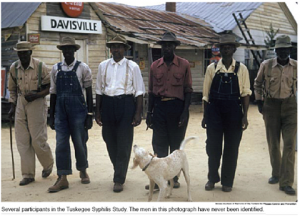
Lest we forget. On Dec. 19 1972, the Tuskegee syphilis experiment was terminated. Today we remember the 623 African-American men who took part in “The Tuskegee Study of Untreated Syphilis in the Negro Male”. For 40 years – 1932 to 1972 – the impoverished and poorly educated men were never told they had syphilis and were never treated for it, even when penicillin became a standard cure in 1947. They were simply told they had ‘bad blood’. For participating in the study, the men received free rides to and from the clinic at Tuskegee University, Alabama. There they were given hot meals and free medical treatment for minor ailments. Any treatments they thought they were also getting for their ‘bad blood’ were actually placebos, aspirin or mineral supplements. When the study ended in 1972 following a public outcry, only 74 of the original participants were still alive. Twenty-eight men had died of the disease and a further hundred or so of related complications. Forty wives had been infected and 19 children had been born with congenital syphilis. In the summer of 1973, a class-action lawsuit was filed on behalf of the study participants and their families. In 1974, a $9 million out-of-court settlement was reached. As part of the settlement, the U.S. government promised to give lifetime medical benefits and burial services to all living participants. In 1975, wives, widows and offspring were added to the program. In 1995, the program was expanded to include health as well as medical benefits. Ernest Hendon, who died in 2004 at 96 was the last living survivor. The last widow receiving THBP benefits died in January 2009. There are 15 offspring currently receiving medical and health benefits. Ernest Hendon, who died in 2004 at 96, was the last living survivor of the infamous Tuskegee syphilis study. Source: http://www.dollsgen.com/tuskspeobit.htm http://www.cdc.gov/tuskegee/timeline.htm http://www.sciencemuseum.org.uk/broughttolife/techniques/tuskegee.aspx
By: Blacks History And Africa Education.
20 Black Inventions Over The Last 100 Years You May Not Know

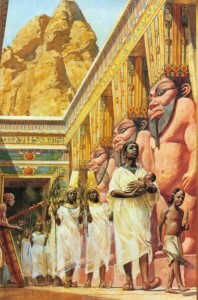
0 responses so far ↓
There are no comments yet...Kick things off by filling out the form below.
Leave a Comment